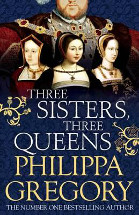Three sisters, three queens by Philippa Gregory

Allen & Unwin, 2016. ISBN 9781471133022
(Age: secondary) Recommended. English history, Tudors, Henry VIII,
Status of women, Scottish history. When Katherine of Aragon comes to
the Tudor court to marry Arthur, his younger sister, Margaret looks
on with petulant disdain. This woman will be her sister in law, but
Margaret is in no mood to be charitable. She will have to take
second place to this foreigner who cannot speak English, and
Margaret above all else, wants to be first.
However, she must be on her best behaviour at their wedding, as an
ambassador is there to confirm her as the wife to be of James IV of
Scotland. She is thrilled to be betrothed at twelve hardly able to
wait until she marries at fourteen to be a queen.
Her younger sister, Mary is initially betrothed to the Spanish
emperor, so the three sisters are to become queens and are all
related through Henry. Katherine of Aragon becomes Queen of England
when she marries Arthur's brother, the future Henry the Eighth,
Margaret is Queen of Scotland and Mary, Queen of France, and their
fictionalised lives make fascinating reading. Gregory's research is
obvious in the huge amount of detail providing a solid background to
these women's imagined lives. Details like James' metal belt worn
next to his skin to remind him of his killing his father or
Katherine's pregnancies and hair shirt, the progress made by the
kings surveying their lands, the clothing and jewelry and
extravagance of Henry's court are intoxicating. And the details of
court behaviour, the differences between the three courts, the
intrigues behind the decisions to declare war and the hapless lives
of these women dependent upon the men in their lives, are absorbing
to read. Margaret's petulance does not subside, she is ever
comparing herself with the other queens, sometimes their solicitous
friend, other times disgruntled and critical.
Her life going between Linlithgow, Holyrood, Edinburgh and Stirling
Castles, carrying six children and losing all but one, is
magnificently retold, ensuring the reader knows all there is to know
about Margaret of Scotland and her part in the Stuart succession to
the throne of England two generations hence.
She is self absorbed, but her life, always bound but her brother's
ambition and political game playing, or that of her husbands and any
people currying her favour, made her a more sympathetic creature,
tossed around in a world where a woman's voice was seldom given
credence.
A wonderful historical novel for those who love reading of Tudor
times, and are particularly interested in the role of women in this
society.
Fran Knight